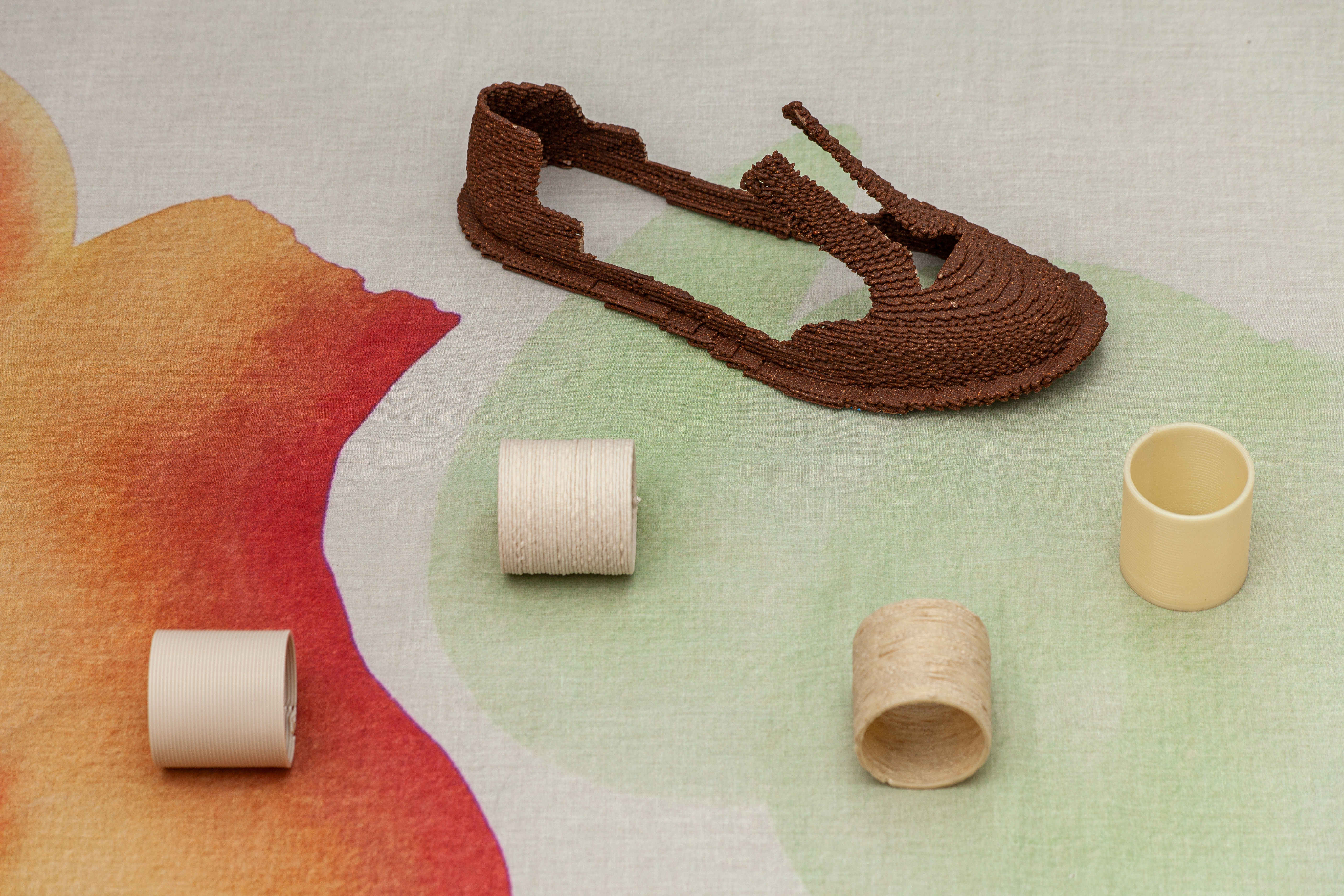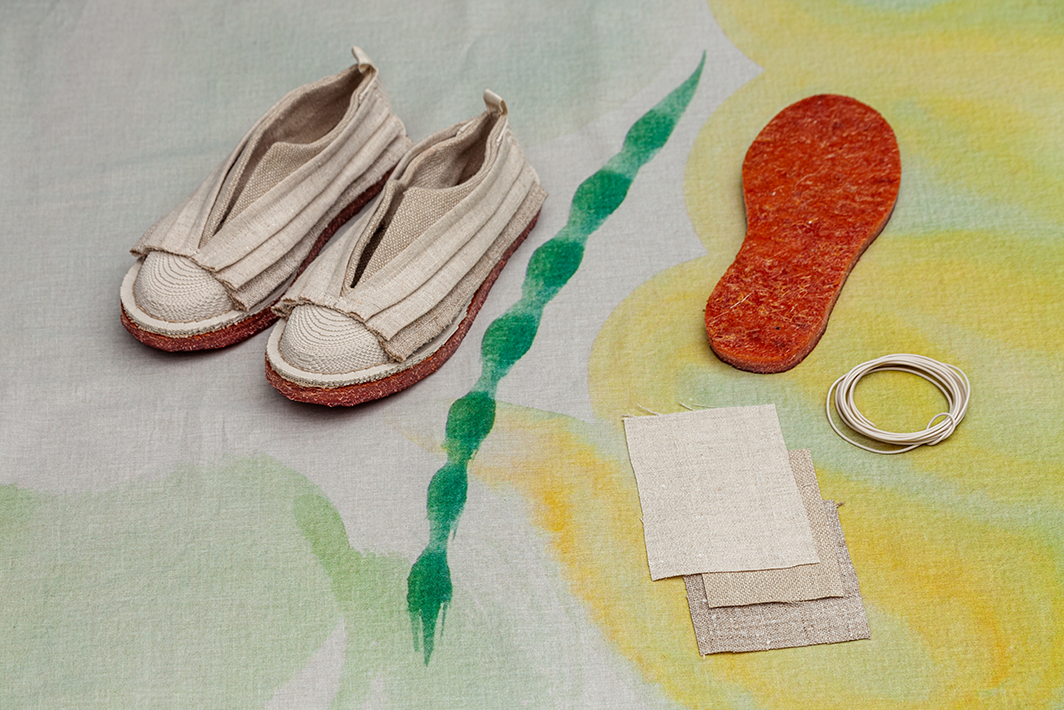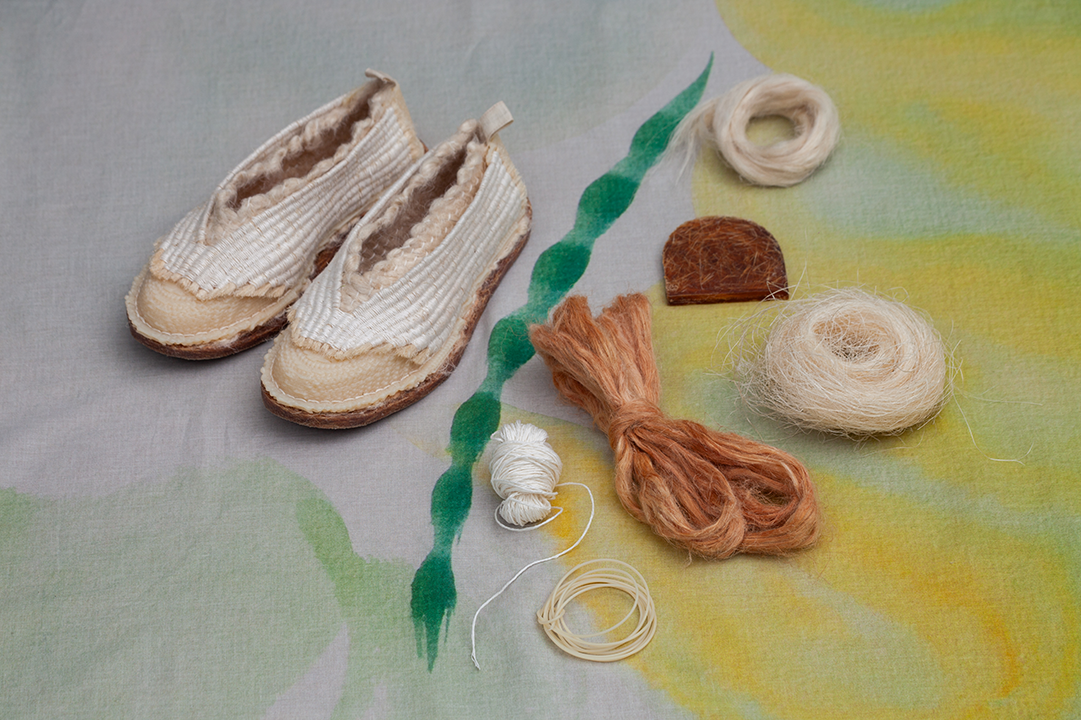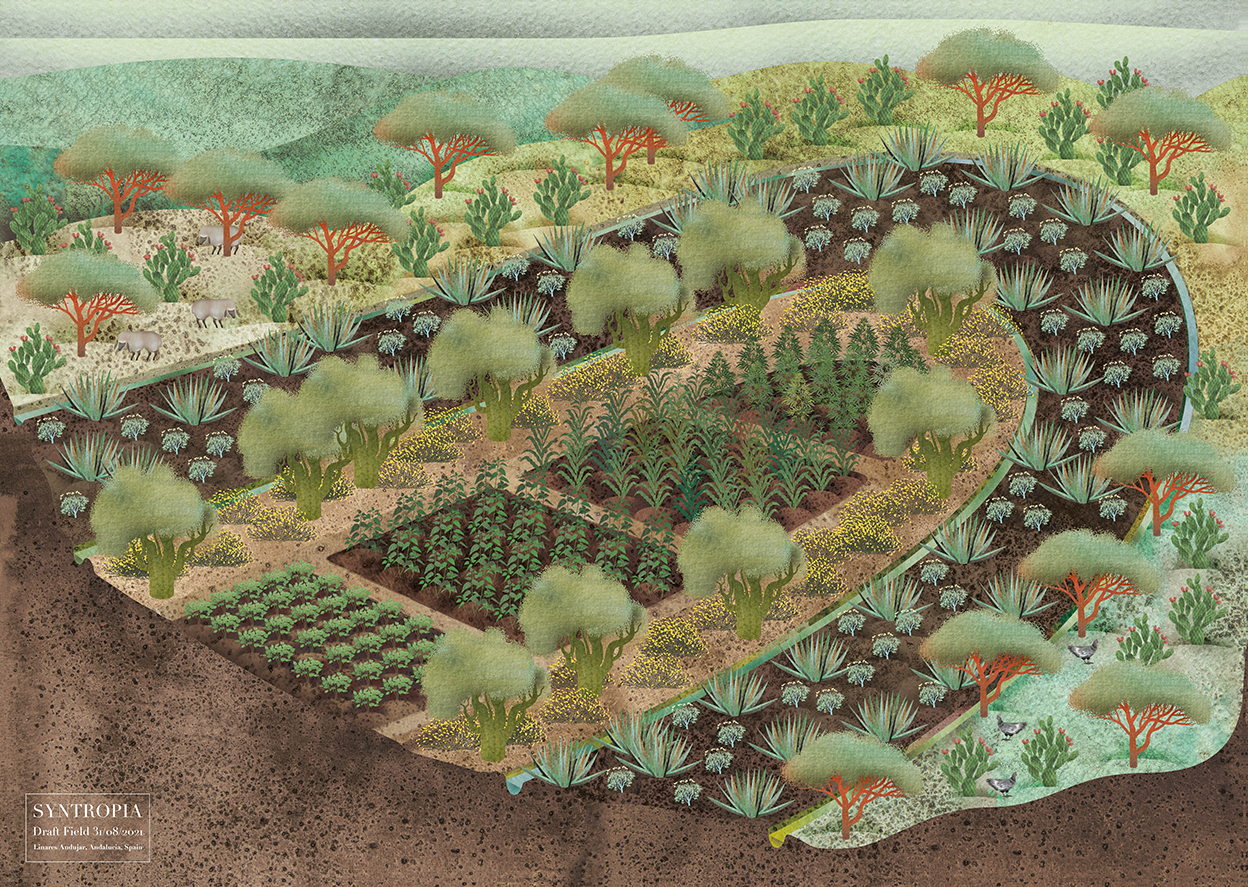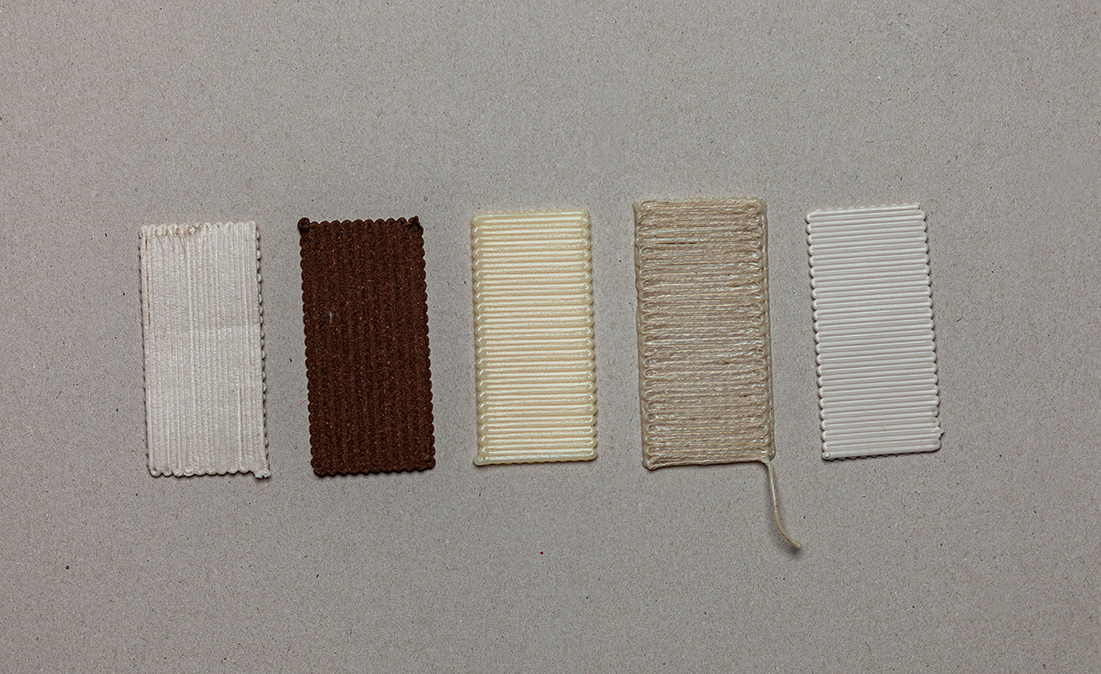In reaction to the current environmental crisis, new bio- based materials are presented almost daily. These materials produced from renewable resources are often derived from industrial agricultural leftovers, but they are also specifically farmed. The monocultural, intensive, extractive farming practices used to produce these resources have major environmental impacts. They include loss of biodiversity, soil depletion and water pollution as well as generating fragile ecosystems in the face of changing climatic conditions.
How can we design systems of production that – directly influence the regeneration of soil, enhance biodiversity and-preserve water in order to create more withstanding ecosystems?
How can we create a product that is repairable and adaptable not only to different scales of production, but also to shifting availability of natural resources?
The research project Syntropia directly relates the production of raw materials to the production of materials and, in extension, products. It proposes a shoe made with bio-based materials which can grow on one polycultural field, in the mountain area of Andalucia in the South of Spain.
Syntropia creates a dialogue between the design and implementation of the polyculture and the design and production of the shoe. The ecosystemic necessities of the multicrop culture determine the design of the shoe and vice versa.
Syntropia is a project funded by Re-fream, a project supported by the European Union as part of the STARTS programme, Horizon 2020.
The foundation of the project Syntropia are two individual projects Ra(h)menschuh by Sophia Guggenberger and Syntropic Materials by Eugenia Morpurgo.
Ra(h)menschuh is an investigation into alternative construction methods for shoe production, based on traditional craft, digital fabrication and industrial strategies.
A traditional shoe can have up to 40 different components, made with a variety of different materials, assembled irreversibly through glue and stitching, limiting possibilities for repair and disposal. Through the development of a simplified construction, components are essentially reduced to four (upper, frame, lining, outsole). The parts are worked without gluing, which means they can be separated, disposed off and repaired, when necessary. Furthermore, the shoes are conceptualized so all the parts can be produced locally, as well as globally. The complexity of production is simplified, not only through the modified construction but also through the use of low threshold tools and the development of a modular last system which further simplifies and minimizes the resources needed.
Although a simplified localised process already presents a more sustainable alternative to the current modes of production, the environmental impact of most materials used still leaves big potential for investigation and improvement.
In reaction to the current environmental crisis, an ever-growing quest for sustainable alternatives to oil-based materials has emerged. In the field of footwear design as much as in other creative disciplines this translated with increasing natural and bio-fabricated options developed at an industrial level as well as at an experimental design-studio level. Among other solutions, many companies, material engineers and designers started looking into the use of industrial agricultural leftovers motivated by the necessity of not stealing land from food production. Based strongly on local bioregional economies, these researches are creating an expanding landscape of natural materials. Despite giving birth to a richer biodiversity of resources, however, these researches are only technical solutions to the use of waste materials and are not questioning the agricultural system that generated them in the first place. They are not providing real alternatives to the environmental impact of monocultural industrial farming.
With her project Syntropic Materials, Eugenia is looking at alternative agroecological models such as regenerative agricultural practices and attempts to combine these with the latest development in natural material research. In order to design regenerative processes for plant/animal based material production. Asking if this great innovation in the field of materials can open new possibilities for the development of polycultures, and vice versa, if the choices taken in designing polycultures could define new directions in new material developments.
The project Syntropia proposes to rethink and reconceptualise the way we produce resources and the products made with them. Currently there are two approaches to sustainable footwear design, one is recycling and the other is the use of bio based materials. Both still rely on big scale industrial production, which in bio materials means industrial monoculture and for recycling the need for plastic waste. While we recognise the current value of these systems we believe that in order to create wholesome viable options for production in the future, we need to rethink the connection between resource and product and relate them to each other before either one gets made; field – material – product.
Our starting point is to develop a shoe based on biomaterials which can grow on the same polycultural field. Thereby taking control of the impact that the materials we are using have on the environment during all steps of their lifecycle. This means the shoe is made solely from renewable resources and these resources are grown in a regenerative polyculture, which allows for enrichment of the soil, limits the use of water and fosters biodiversity. We are proposing to design a sustainable resource management as well as challenging existing strategies for material management and footwear production.
In order to reach a first draft for this polyculture we started a collaboration with Spanish agronomist Fernando Bautista Expósito.
Right from the start it became clear that we needed to localise the project in a specific territory. The climatic and environmental restrictions would create the frame for the research of species and consequently the materials research.
Together with Fernando Bautista Expósito we structured the collaboration process where two main aspects had to be considered: the technical requirements the materials needed to fulfill in order to be used in footwear and the particular resources a geographically localised field could provide us with.
If looking at using a flexible polymer (flexible bioplastic) for the outsole of the shoe, based on Polylactic Acid (PLA) which is usually made from corn starch, the questions could be:
Technical Requirements:
What are the specifications in relation to hardness, flexibility, abrasion, etc.?
What technologies/processes can be used to manipulate the material?
What quantities do we need?
Agricultural Requirements: provided that our goal is to create a polycultural field which does not rely on fertilisers/pesticides or high amounts of water:
How do we combine the species to be grown together and in which quantities do we have to grow them
How do we balance these requirements with the productive quantities required for the production of the shoes?
After defining the general characteristics necessary for the shoe, we generated an initial list of species and materials commonly available on the market. This allowed us to create a first archive of physical samples to study and experiment with.
Starting from the initial list of plants that we created, Fernando Bautista Expòsito narrowed down the geographical position of the project even further and led us to the region of Andalucia, in the South of Spain, another area with a long tradition in footwear manufacturing.
He evaluated the already present species in terms of their climatic needs and their presence in the agricultural landscape of the Iberian Peninsula. He then added relevant species with similar or complementary characteristics already growing in Andalucia. He also expanded the range of information from material production to include the ideal climatic conditions and other relevant information connected to the potential or problematic growth of these species.
Since the initial iteration, the list has become an archive of a variety of different aspects, allowing us to further investigate production processes and material use.
Most of the species we looked into played an important role in the world of manufacturing and agriculture prior to the Industrial and the Green Revolution.
Due to hands-on experimentation, and a constant focus on the evaluation of material qualities and agronomical consideration, the list became gradually more refined. Ultimately, producing a list of 16 potential species which could be farmed together in Andalusia, in a polycultural setting and could be used as raw materials for the production of our shoe.
This process of research and development, taking into consideration environmental multispecies needs as well as technical manufacturing requirements into consideration has been very new to us and to Fernando.
We are convinced that the concept and approach we were developing is relevant not only within the specific context of sustainable footwear manufacturing in the Mediterranean context, but globally. This is why sharing the documentation as well as sharing the process is just as important as the “final” results themselves.
For what concerns the material research development we divided the components of the shoe into two groups: the upper and lining, the frame and outsole.
For the upper and lining we were looking for various loose fibres, spun yarns, fabrics and new material developments such as alternative leathers and fabric from banana fibres.
For frame and outsole we focused on the research of bio based alternatives for the synthetic polymers used in most shoe production today, such as flexible PLA and natural rubbers as well as the plants that produce them.
In order to create a realistic viable perspective for shoe production, one of our main focuses had to be the use and application of polymers.
We then identified two main sources for flexible bio based polymers available to us:
Flexible Polylactic Acid (PLA) made from corn starch
Natural Rubber from Hevea Brasiliensis
We think it is absolutely vital to reflect on the use of polymers in footwear production: even if biobased, the impact their production and disposal has on our ecosystems is still in no relation to naturally sourced fabrics. Therefore, we wanted to investigate the possibilities of material compounds in order to allow us to minimise the amounts of polymer needed for the production of the components, and the possibility of finding new material properties.
Early on in our investigation we found research on the production and use of filaments reinforced with endless fibres. With the help of our co-creation partner Haratech we approached WoodKplus, a research institute part of the Johannes Kepler University as external partner to develop the fibre reinforced filament with us. Together we developed a strategy for testing two different types of flexible PLA to be made into a 1.75mm filament with a continuous 1 mm cotton thread, a continuous 0.5 mm hemp thread and a PLA filament blended with loose fibres.
In order to select the materials to test with the polymers we were focused on achieving a high variety of different options. The first task at hand was finding suitable thread dimensions to use. In the end we did manage to source a 1mm cotton warp thread used for weaving and a 0.5mm hemp thread, however, this issue stayed with us until the very end, when we were trying to source regular threads corresponding to the materials available on our field.
In order to be able to have results for at least on blended filament we then opted to use cork powder, where we knew there were chances for it being available to us in the needed quality.
Next to developing 3d- printing with bio based filaments, we were also working on the possibilities of using natural rubber composites. Natural rubber sap is a raw material mostly harvested from the rubber tree (hevea brasiliensis) in Southeast Asia. During our research we explored alternatives for latex producing plants as well as experimenting with blending latex with natural fibres to create a material composite which minimises the quantities of natural rubber needed.
The shoes
The combinations of findings from the polyculture, materials, and footwear production research resulted in four variations of the Syntropia shoe.
The shoe can be seen as a flexible framework, where each component can be produced with different levels of technological complexity according to the infrastructure locally available. The upper can be hand crafted as much as industrially manufactured. The outsole can be 3d printed on demand, cut from standardised rubber sheets or produced in higher numbers by mold casting. This approach proposes a system which uses appropriate technologies in relation to the potential local context of production. This flexibility can be found also in the materials used to manufacture the shoes. Working with materials derived from a biodiverse agro ecological system challenges us to implement the same richness in biodiversity of materials in the design of the shoe. Following seasonality through the years, we aim not to rely on one resource alone. We designed a product where each component can be manufactured using a variety of different resources respecting the unpredictability of natural cycles.
Four prototypes which represent the quest of allowing flexibility in the materials used and in the production systems employed:
1- Shoe made from industrially produced hemp fabrics, PLA and an outsole made from natural latex mixed with wool fibres.
2- Shoe made from industrially made hemp and nettle fabric, PLA and an outsole made of natural latex mixed with cochineal dyed sisal fibres.
3- Shoe made from handwoven nettle and hemp yarn, woven hemp fibres and nettle yarn, PLA and an outsole made of natural latex mixed with cork dust.
4- Shoe made from sisal fibres handwoven with hemp yarn and woven hemp fibres with hemp yarn, PLA and an outsole made from natural latex mixed with sisal fibres.
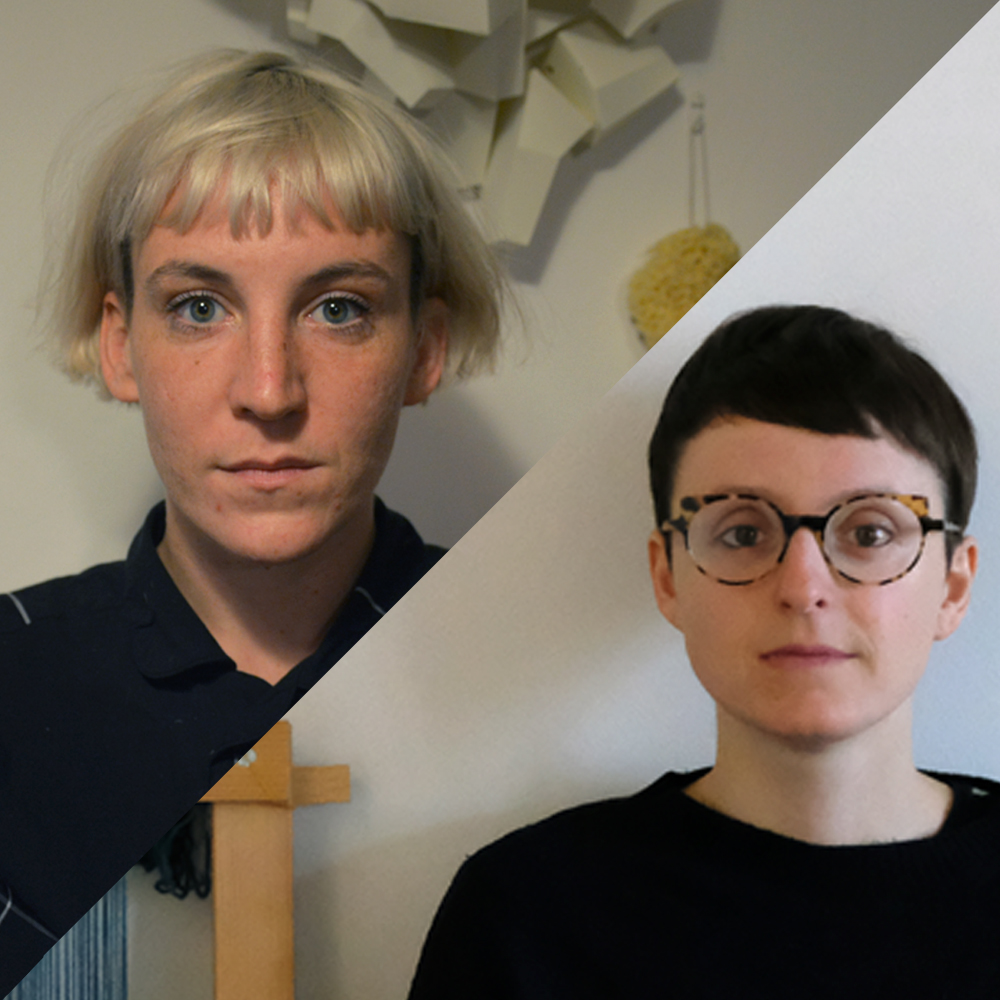
Eugenia Morpurgo, Sophia Guggenberger
Italy
Syntropia is a project initiated by Sophia Guggenberger and Eugenia Morpurgo and has been developed in the frame of the European funded project Re-fream.
Project developed in collaboration with Haratech, WoodKPlus and the Fashion & Technology department at the Kunstuniversität Linz, Empa, Fernando Bautista Expósito, Anastasija Mass and Elisabeth Handl.
Sophia Guggenberger is a designer/maker continuously working on developing alternative strategies for the production of footwear. She is researching not only the technical aspects of these specific processes but also the wider implications of employing different production methods; mixing craft, industrial strategies as well as digital fabrication.
Eugenia Morpurgo is an independent designer researching the impact that production processes have on society, with a focus on investigating and prototyping alternative scenarios and products. She works through self initiated projects and commissioned work from cultural institutions, Universities and Fablabs.





